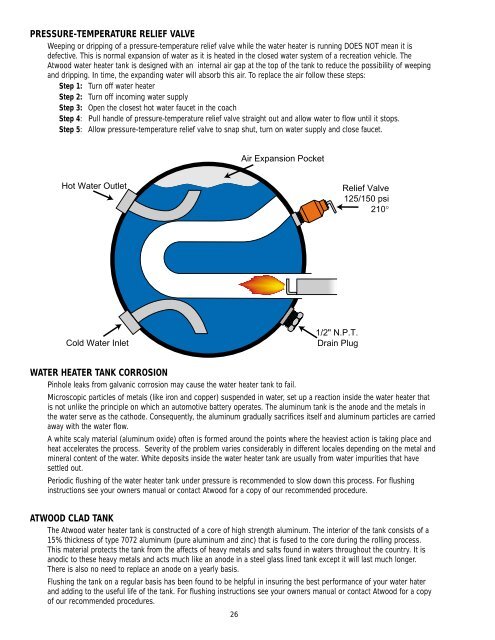Atwood Water Heater - RV Owner's Manuals
Atwood Water Heater - RV Owner's Manuals
Atwood Water Heater - RV Owner's Manuals
Create successful ePaper yourself
Turn your PDF publications into a flip-book with our unique Google optimized e-Paper software.
PRESSURE-TEMPERATURE RELIEF VALVE<br />
Weeping or dripping of a pressure-temperature relief valve while the water heater is running DOES NOT mean it is<br />
defective. This is normal expansion of water as it is heated in the closed water system of a recreation vehicle. The<br />
<strong>Atwood</strong> water heater tank is designed with an internal air gap at the top of the tank to reduce the possibility of weeping<br />
and dripping. In time, the expanding water will absorb this air. To replace the air follow these steps:<br />
Step 1: Turn off water heater<br />
Step 2: Turn off incoming water supply<br />
Step 3: Open the closest hot water faucet in the coach<br />
Step 4: Pull handle of pressure-temperature relief valve straight out and allow water to flow until it stops.<br />
Step 5: Allow pressure-temperature relief valve to snap shut, turn on water supply and close faucet.<br />
Air Expansion Pocket<br />
Hot <strong>Water</strong> Outlet<br />
Relief Valve<br />
125/150 psi<br />
210°<br />
Cold <strong>Water</strong> Inlet<br />
1/2" N.P.T.<br />
Drain Plug<br />
WATER HEATER TANK CORROSION<br />
Pinhole leaks from galvanic corrosion may cause the water heater tank to fail.<br />
Microscopic particles of metals (like iron and copper) suspended in water, set up a reaction inside the water heater that<br />
is not unlike the principle on which an automotive battery operates. The aluminum tank is the anode and the metals in<br />
the water serve as the cathode. Consequently, the aluminum gradually sacrifices itself and aluminum particles are carried<br />
away with the water flow.<br />
A white scaly material (aluminum oxide) often is formed around the points where the heaviest action is taking place and<br />
heat accelerates the process. Severity of the problem varies considerably in different locales depending on the metal and<br />
mineral content of the water. White deposits inside the water heater tank are usually from water impurities that have<br />
settled out.<br />
Periodic flushing of the water heater tank under pressure is recommended to slow down this process. For flushing<br />
instructions see your owners manual or contact <strong>Atwood</strong> for a copy of our recommended procedure.<br />
ATWOOD CLAD TANK<br />
The <strong>Atwood</strong> water heater tank is constructed of a core of high strength aluminum. The interior of the tank consists of a<br />
15% thickness of type 7072 aluminum (pure aluminum and zinc) that is fused to the core during the rolling process.<br />
This material protects the tank from the affects of heavy metals and salts found in waters throughout the country. It is<br />
anodic to these heavy metals and acts much like an anode in a steel glass lined tank except it will last much longer.<br />
There is also no need to replace an anode on a yearly basis.<br />
Flushing the tank on a regular basis has been found to be helpful in insuring the best performance of your water hater<br />
and adding to the useful life of the tank. For flushing instructions see your owners manual or contact <strong>Atwood</strong> for a copy<br />
of our recommended procedures.<br />
26


